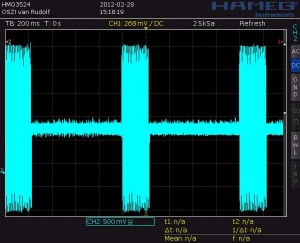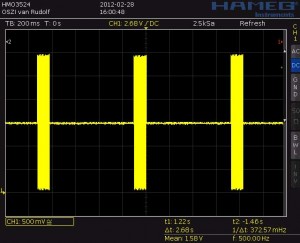While testing avalanche transceivers this year it has become more evident that older, analog type beacons should be retired. It isn’t because they don’t work. But the way they work can cause trouble in the dreaded multiple victim scenario. If you have more than one person buried in an avalanche the odds are at least one person will turn up dead. The odds of that increase if one of the victims has an old analog beacon.

Screen capture of the received signal from an analog beacon. Notice how the signal never fully turns off - and the extra wide pulse increases the chance of signals overlapping.
When you are within 2 meters the strength of the signal from an analog beacon is stronger than the ON pulse of another beacon that is approximately 30 meters away. That distance, of course, depends on spatial orientation.
By comparison, with modern digital beacons when they’re off, there is no signal being created. The oscillator circuit that generates the 457 kHz signal is not producing a signal until it is time to turn it on and transmit it. Notice how small the line is between pulses for the digital beacon compared to how fat is is for an F1. The height of the pulse and corresponding lack or presence of it between pulses indicates the strength of the signal between pulses.

Received signal from a recent model digital beacon. Notice how little signal there is between pulses? And how narrow each pulse width is?
The end result is avalanche transceivers that are great at detecting and helping you find multiple victims, like Barryvox’s Pulse and Element, the Pieps DSP and DSP Tour, and Ortovox’ S1 can become “confused,” which inevitably slows down search times and compromises a victim’s survival chances.
Now I’m not advocating for some rule or law from higher up, I’m just encouraging you that if your avalanche transceiver is an Ortovox F1 Focus, a Pieps 457, or an Arva 457, please upgrade your beacon. You may appreciate it some day, and if you’re caught with another friend they most certainly will appreciate that. And don’t sell ’em to a stranger either. If you can’t bring yourself to trash it, use it for multiple beacon searches and you’ll see what I mean by how easily it confuses you and others. When you’re frustrated enough, take a hammer to it.
In keeping with that sentiment, this is the last season you can buy an Ortovox F1, but don’t; let someone else make that decision.
© 2012

10 pings
Skip to comment form
[…] for optimal range, co-polarized with Neo’s receiving antenna. Off to starboard was an F1, just to mess with the ability to distinguish signals. Near the F1 was a Pieps dangling […]
[…] few times in both search and transmit mode. For step-by-step tutorials, websites like WildSnow and EarnYourTurns have in-depth posts on how to test your beacon and determining whether it’s time to update or […]
[…] model digital beacon and an Ortovox F1. The F1 has a continuous carrier signal, which is noisy. This noisy signal is the most likely to create difficulty for a simple microprocessor driven algorithm to correctly […]